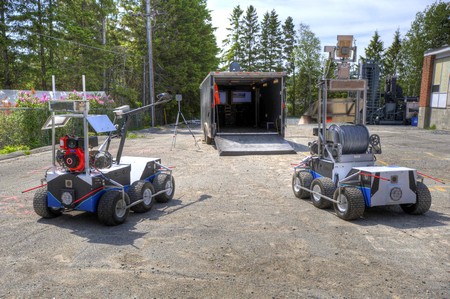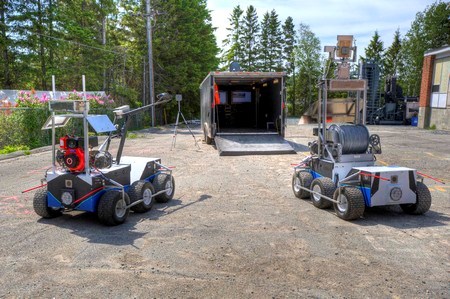
Penguin Automated Systems of Sudbury has developed two robotic vehicles to survey an open stope at Xstrata Nickel's Montcalm Mine, which was closed in March 2009 due to an unplanned ground fall following a stope blast.The mine, 70 kilometres northwest of Timmins, is considered unsafe to enter, so the only way to determine whether the ground is continuing to move is to use robots to do cavity monitoring, said Greg Baiden, Penguin's chairman and chief technology officer at a technical session held during the Canadian Institute of Mining and Metallurgy's Maintenance Engineering and Mine Operators (MEMO) conference in Sudbury, October 27th.
Two, six-wheeled robots were built for the task: the so-called Combot, which provides a 10 mb/s telecommunications link to a teleoperation trailer at the mine's portal, and a workbot, which can be equipped with a cutting arm and a boom capable of extending a laser scanner 30 feet (nine metres) into the open stope.
"The teleoperated robots are driven a distance of 1.2 kilometres down a steep ramp that's eroded away," said Baiden. "There's no communication infrastructure, no lighting and no ventilation, so it's a very difficult robotic challenge.”
The robots establish the communication infrastructure as they descend into the mine by dropping WiFi communication pylons along the way. The vehicle frame is capable of folding in order to cross deep ditches on the ramp.
Two low speed/high torque stepper motors are powered by 12 gel cell batteries that allow for 16 hours of operation at full load. Low light cameras and LED headlights allow Penguin staff to teleoperate the robots.
The workbot can be equipped with a robotic arm capable of raising, lowering, extending and retracting. The end of the arm is designed to hold hand tools such as a grinder, which is needed to cut through a metal safety fence around the stope. It can also be equipped with another robotic arm designed to extend a laser scanner into the cavity.
The two robots were deployed at Montcalm at the end of August following several months of testing at Penguin’s facility in Sudbury. The Combot descended 250 metres down the ramp, while the Workbot dropped a portable transceiver at the 400-metre mark and carried on another 200 metres.
Both robots successfully returned to the mine portal.
The trial run paves the way for a full mission to be carried out following some final adjustments.
The intention is to use the robots to survey the cavity over a period of time to see if there is any further ground movement and to help Xstrata make a decision about the future of the mine.
According to Baiden, teleoperated robots are ideal for entering and assessing mines or openings that are unsafe for mine personnel.
Montcalm commenced operations in 2004, was producing at a rate of 9,000 tonnes of nickel concentrate per year and was expected to continue in operation until the end of 2011.
Penguin is also working on a teleoperation assignment for Codelco’s Radomiro Tomic open pit copper mine in Chile, where the objective is to teleoperate the stacker and bucket wheel that deposit and extract ore from two heap leach pads 500 metres wide by two kilometres long. Teleoperation would remove equipment operators from the acidic fumes, extreme temperatures and burning sun, and allow them to do their jobs in greater comfort.
Based in an air-conditioned teleoperation centre in Calama, 30 kilometres from the mine site, equipment operators will spend less time travelling to the mine site and won’t have to endure the physical hardship of climbing up and down the equipment several times a day.
Teleoperation will be safer and result in improved productivity, said Baiden.
The system is currently being designed and planned for deployment in the third quarter of 2011. The biggest challenge, said Baiden, is maneuvering a gigantic piece of equipment that’s 500 metres long.



